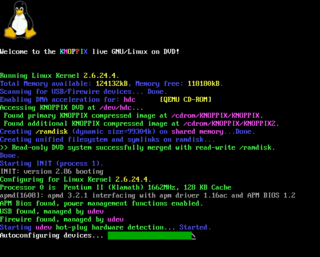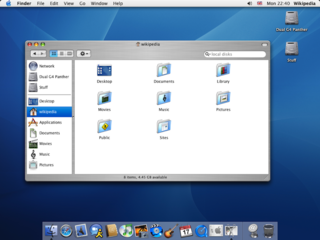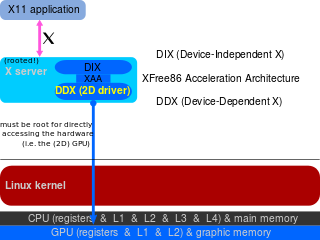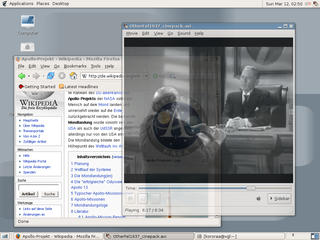
The X Window System is a windowing system for bitmap displays, common on Unix-like operating systems.

XFree86 is an implementation of the X Window System. It was originally written for Unix-like operating systems on IBM PC compatibles and was available for many other operating systems and platforms. It is free and open source software under the XFree86 License version 1.1. It was developed by the XFree86 Project, Inc. The lead developer was David Dawes. The last released version was 4.8.0, released December 2008. The last XFree86 CVS commit was made on May 18, 2009; the project was confirmed dormant in December 2011.

The Linux framebuffer (fbdev) is a linux subsystem used to show graphics on a computer monitor, typically on the system console.

Mac OS X Panther is the fourth major release of macOS, Apple's desktop and server operating system. It followed Mac OS X Jaguar and preceded Mac OS X Tiger. It was released on October 24, 2003, with the retail price of US$129 for a single user and US$199 for a five user, family license.

XQuartz is an open-source version of the X.Org X server, a display server for the X Window System that runs on macOS. It formally replaced Apple's internal X11 app. The name "XQuartz" derives from Quartz, part of the macOS Core Graphics framework, to which XQuartz connects these applications. XQuartz allows cross-platform applications using X11 for the GUI to run on macOS, many of which are not specifically designed for macOS. This includes numerous scientific and academic software projects.

The X.Org Foundation is a non-profit corporation chartered to research, develop, support, organize, administrate, standardize, promote, and defend a free and open accelerated graphics stack. This includes, but is not limited to, the following projects: DRM, Mesa 3D, Wayland, and the X Window System and its primary implementation, the X.Org Server.
X.Org Server is the free and open-source implementation of the X Window System (X11) display server stewarded by the X.Org Foundation.
GLX is an extension to the X Window System core protocol providing an interface between OpenGL and the X Window System as well as extensions to OpenGL itself. It enables programs wishing to use OpenGL to do so within a window provided by the X Window System. GLX distinguishes two "states": indirect state and direct state.
The X video extension, often abbreviated as XVideo or Xv, is a video output mechanism for the X Window System. The protocol was designed by David Carver; the specification for version 2 of the protocol was written in July 1991. It is mainly used today to resize video content in the video controller hardware in order to enlarge a given video or to watch it in full screen mode. Without XVideo, X would have to do this scaling on the main CPU. That requires a considerable amount of processing power, which could slow down or degrade the video stream; video controllers are specifically designed for this kind of computation, so can do it much more cheaply. Similarly, the X video extension can have the video controller perform color space conversions, and change the contrast, brightness, and hue of a displayed video stream.

Xinerama is an extension to the X Window System that enables X applications and window managers to use two or more physical displays as one large virtual display.
PHIGS is an application programming interface (API) standard for rendering 3D computer graphics, considered to be the 3D graphics standard for the 1980s through the early 1990s. Subsequently, a combination of features and power led to the rise of OpenGL, which became the most popular professional 3D API of the mid to late 1990s.

The Direct Rendering Infrastructure (DRI) is the framework comprising the modern Linux graphics stack which allows unprivileged user-space programs to issue commands to graphics hardware without conflicting with other programs. The main use of DRI is to provide hardware acceleration for the Mesa implementation of OpenGL. DRI has also been adapted to provide OpenGL acceleration on a framebuffer console without a display server running.

In computing, EXA is a graphics acceleration architecture of the X.Org Server designed to replace XAA and to make the XRender extension more usable, with only minor changes needed to adapt obsolete XFree86 video drivers written to use XAA; it was designed by Zack Rusin and announced at LinuxTag 2005 and first released with X.Org Server version 6.9/7.0.
The Direct Rendering Manager (DRM) is a subsystem of the Linux kernel responsible for interfacing with GPUs of modern video cards. DRM exposes an API that user-space programs can use to send commands and data to the GPU and perform operations such as configuring the mode setting of the display. DRM was first developed as the kernel-space component of the X Server Direct Rendering Infrastructure, but since then it has been used by other graphic stack alternatives such as Wayland and standalone applications and libraries such as SDL2 and Kodi.

XDarwin is an obsolete X Window System (X11) display server for the Darwin operating system and early versions of Mac OS X. XDarwin allows one to use programs written for X11 on those operating systems.

Xgl is an obsolete display server implementation supporting the X Window System protocol designed to take advantage of modern graphics cards via their OpenGL drivers, layered on top of OpenGL. It supports hardware acceleration of all X, OpenGL and XVideo applications and graphical effects by a compositing window manager such as Compiz or Beryl. The project was started by David Reveman of Novell and first released on January 2, 2006. It was removed from the X.org server in favor of AIGLX on June 12, 2008.
Xsun is an X Window System (X11) display server implementation included with Solaris, developed by Sun Microsystems. It replaced the older Xnews server, which supported the display of not only X11 applications, but also NeWS and SunView programs. Xsun discontinued support for these legacy environments, and added support for Display PostScript.
X-Video Motion Compensation (XvMC), is an extension of the X video extension (Xv) for the X Window System. The XvMC API allows video programs to offload portions of the video decoding process to the GPU video-hardware. In theory this process should also reduce bus bandwidth requirements. Currently, the supported portions to be offloaded by XvMC onto the GPU are motion compensation and inverse discrete cosine transform (iDCT) for MPEG-2 video. XvMC also supports offloading decoding of mo comp, iDCT, and VLD for not only MPEG-2 but also MPEG-4 ASP video on VIA Unichrome hardware.
X386 was an implementation of the X Window System for IBM PC compatible computers. It ran on systems with Intel 386 or later processors, running Unix System V-based operating systems, and supported a variety of VGA-compatible graphics cards. X386 was created by Thomas Roell while at Technische Universität München and first released in 1991. X386 1.2 was incorporated in the X11R5 release later the same year.
A modeline is a configuration line in xorg.conf or the XFree86 configuration file (XF86Config) that provides information to the display server about a connected computer monitor or television and how to drive it at a specified display resolution. The Modeline is based on the Generalized Timing Formula or the Coordinated Video Timings standards produced by VESA.









